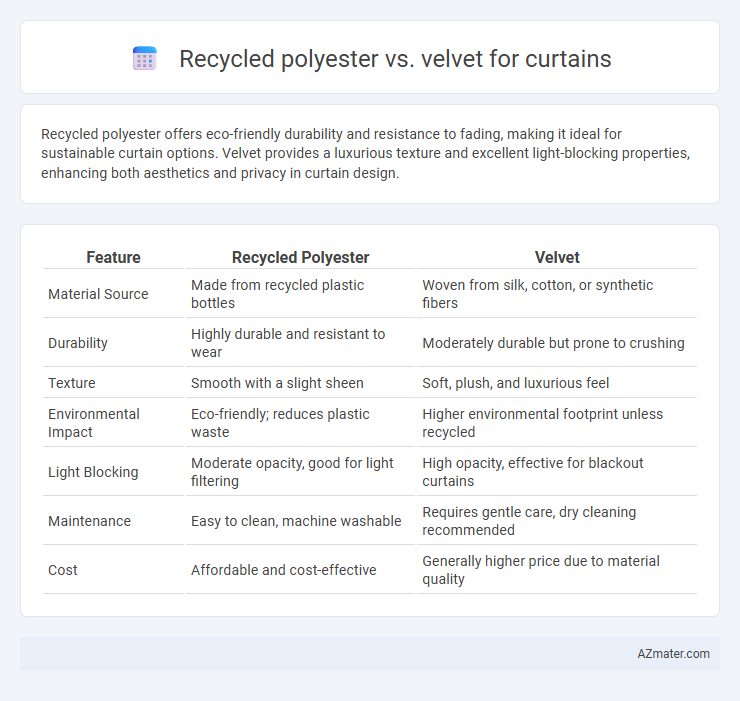Recycled polyester offers eco-friendly durability and resistance to fading, making it ideal for sustainable curtain options. Velvet provides a luxurious texture and excellent light-blocking properties, enhancing both aesthetics and privacy in curtain design.
Table of Comparison
| Feature | Recycled Polyester | Velvet |
|---|---|---|
| Material Source | Made from recycled plastic bottles | Woven from silk, cotton, or synthetic fibers |
| Durability | Highly durable and resistant to wear | Moderately durable but prone to crushing |
| Texture | Smooth with a slight sheen | Soft, plush, and luxurious feel |
| Environmental Impact | Eco-friendly; reduces plastic waste | Higher environmental footprint unless recycled |
| Light Blocking | Moderate opacity, good for light filtering | High opacity, effective for blackout curtains |
| Maintenance | Easy to clean, machine washable | Requires gentle care, dry cleaning recommended |
| Cost | Affordable and cost-effective | Generally higher price due to material quality |
Introduction: Comparing Recycled Polyester and Velvet Curtains
Recycled polyester curtains offer an eco-friendly alternative with durability, easy maintenance, and resistance to fading and wrinkles. Velvet curtains provide a luxurious texture, enhanced insulation, and superior light blocking, creating a rich aesthetic suitable for elegant interiors. Choosing between recycled polyester and velvet depends on sustainability priorities, desired texture, and room ambiance.
Material Overview: What is Recycled Polyester?
Recycled polyester is a sustainable fabric made from repurposed plastic bottles and industrial polyester waste, reducing reliance on virgin petroleum-based fibers. It offers durability, resistance to wrinkles and shrinking, making it ideal for curtains that require longevity and easy maintenance. Compared to velvet, recycled polyester provides a more eco-friendly option with a smoother texture and often lighter weight, while velvet is known for its plushness and luxurious feel.
Material Overview: What is Velvet?
Velvet is a woven fabric characterized by its dense pile of evenly cut fibers that create a soft, luxurious texture and a distinctive sheen, commonly made from silk, cotton, or synthetic fibers. Its unique structure provides excellent insulation and draping qualities, making it a popular choice for curtains that demand both elegance and functionality. When compared to recycled polyester, velvet offers a richer tactile experience but may require more careful maintenance and higher production costs.
Environmental Impact: Sustainability of Recycled Polyester vs Velvet
Recycled polyester is made from post-consumer plastics, significantly reducing waste and lowering carbon emissions compared to virgin polyester, making it a more sustainable choice for curtains. Velvet, typically made from natural fibers like cotton or synthetics such as polyester, often involves higher water and energy consumption during production, impacting its environmental footprint. Choosing recycled polyester for curtains supports circular economy principles by minimizing resource extraction and promoting waste reuse.
Texture and Aesthetic Appeal: Differences in Look and Feel
Recycled polyester curtains offer a smooth, lightweight texture with a consistent finish that enhances modern, minimalist aesthetics while providing durability and eco-friendly benefits. Velvet curtains feature a rich, plush texture with a soft, luxurious feel that adds depth and warmth, making them ideal for traditional or elegant interior designs. The tactile difference is notable: recycled polyester feels sleek and slightly crisp, whereas velvet is dense and velvety, influencing the overall ambiance and visual richness of a room.
Durability and Maintenance: Longevity of Each Fabric
Recycled polyester curtains exhibit high durability and resistance to fading, making them ideal for long-term use in various environments, while requiring minimal maintenance such as simple machine washing or gentle spot cleaning. Velvet curtains, known for their luxurious texture and thickness, offer excellent durability but demand more careful upkeep, including professional cleaning or delicate hand washing to maintain their plush appearance and prevent fabric wear. The longevity of recycled polyester far exceeds typical velvet durability when exposed to frequent light and cleaning cycles, positioning it as a practical choice for eco-conscious, low-maintenance window treatments.
Cost Comparison: Price Differences Explained
Recycled polyester curtains typically cost 20-40% less than velvet curtains due to lower raw material and production expenses. Velvet curtains, made from plush, densely woven fabric, demand higher manufacturing costs, driving their price significantly above $50 per yard, compared to recycled polyester's average $10-$20 per yard. The cost differential is largely influenced by material quality, durability, and aesthetic appeal, with velvet positioned as a premium option and recycled polyester as a budget-friendly, eco-conscious alternative.
Suitability: Best Uses for Each Curtain Material
Recycled polyester curtains are highly suitable for eco-conscious spaces due to their durability, moisture resistance, and easy maintenance, making them ideal for high-traffic areas or humid environments like kitchens and bathrooms. Velvet curtains offer luxurious aesthetics and excellent light-blocking properties, perfect for bedrooms or living rooms where privacy and insulation are priorities. Both materials serve distinct purposes: recycled polyester excels in practicality and sustainability, while velvet enhances elegance and comfort.
Allergies and Safety: Health Considerations
Recycled polyester curtains offer hypoallergenic properties, as they resist dust mites and mold, reducing allergy triggers compared to velvet. Velvet, made from natural or synthetic fibers, can trap more dust and allergens, potentially aggravating respiratory issues. Choosing recycled polyester enhances indoor air quality and safety, especially for allergy sufferers and asthma patients.
Conclusion: Choosing the Right Curtain Material for Your Space
Recycled polyester offers durability, eco-friendliness, and resistance to fading, making it ideal for high-traffic areas and environmentally conscious spaces. Velvet provides a luxurious texture and excellent light-blocking properties, enhancing insulation and creating a cozy atmosphere. Selecting between recycled polyester and velvet depends on your priority for sustainability versus elegance and warmth in your room design.

Infographic: Recycled polyester vs Velvet for Curtain
 azmater.com
azmater.com